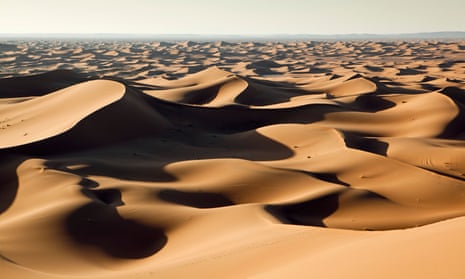For Paul Bowles, the Sahara was “one of the last great terrae incognitae left on this shrinking planet”. His 1949 novel The Sheltering Sky was inspired by the desert’s “intensely poetic” dunes and in a later essay he described its impact on him: “In this wholly mineral landscape lighted by stars like flares, even memory disappears; nothing is left but your own breathing and the sound of your heart beating … For no one who has stayed in the Sahara for a while is quite the same as when he came.”
The Sahara is vast, covering about a third of the continent of Africa. From the Atlantic to the Red Sea it sprawls across 4,800km, and from its southern to its northern limit is a distance of some 1,800km . It is, said Bowles, “a continent within a continent”, with its own mountain ranges, plains, dunes, valleys and volcanic craters. And yet its lakes are made of salt and its forests are no longer alive but petrified fossils. For most of this lunar landscape is without vegetation or even soil. He found the experience like travelling to another planet: “Not a blade of grass for hundreds of miles. Stark black hills rising from endless plains with a thin surface layer of fine gravel. Great humpbacked sand dunes aligned in seemingly endless rows parallel to the wind. Sand, dust, and wind; wind, dust, and sand.”
But it has not always been like this. Martin Williams, a professor of earth sciences at the University of Adelaide, has seen for himself how, on rock faces deep in the desert, prehistoric artists had scratched or painted evocative scenes of long-lost people herding cattle, as well as images of giraffes and elephants. He helped excavate the oldest complete domestic cow skeleton ever found in the Sahara, a relic from 5,000 years ago. The bones were stumbled upon during an early morning walk at the isolated mountain of Adrar Bous which, he notes, is “about as far inland as it is possible to be in north Africa, which is one reason why it is so dry”. This, together with the discovery of Neolithic pottery and tools, proved that farmers and herders were living in that area 5,000 years ago. According to Williams, “the stark contrast between present aridity and the overwhelming evidence of a recently wetter past has led me on a lifelong journey”.
Williams’s book is the fruit of that journey. The general reader may find it technical in parts, but it is a detailed and authoritative account that reveals the rich and fascinating story of this unique landscape and its climate, geology and natural history.
The Sahara began to dry out some 7m years ago, principally due to the slow drift of the continent of Africa into latitudes characterised by drier air. Rain-bearing clouds shed their moisture before they could get to it. “The Sahara existed as a desert millions of years before humans ever appeared on the scene,” writes Williams.
But on a number of occasions the Sahara has been a green and pleasant land. The last time was between 15,000 and 5,000 years ago. Back then, the tropics received more radiation from the sun, and summer and winter rains reached into the heart of this now barren land. Vegetation belts in the north and the south spread more than 1,000km farther inland than their current limits. It was a land of tropical savannah and grassland, with lakes and rivers filled with an abundance of life.
But from about 5,000 years ago the Sahara began to dry out again. Williams rejects theories that early humans were the principal cause of this, due to deforestation and overgrazing: “The Sahara is dry today for good and sufficient geographical reasons that have nothing to do with humans.” In answer to the question of whether the Sahara will one day be green again he replies: “Yes, but not for a long time to come.”
Williams admires those who continue to live in the Sahara for their deep understanding of nature and ability to survive in such a harsh environment. He describes how on one journey they needed to drink from a muddy pool. When he offered to filter the mud using his shirt, their “aristocratic young Tuareg guide curled his lips in scorn and dispatched his younger brother with a small axe to obtain some pieces of bark from a particular tree”. Added to a calabash of the muddy water, the bark caused the organic matter to settle within minutes, leaving the liquid crystal-clear.
Williams’s book offers a wonderful insight into how climate can transform the landscape across long stretches of time, as well as how delicately balanced are the ecosystems on which we depend. All the more reason, Williams writes, to “cherish the wisdom of past peoples who learned to live in greater harmony with their land than many of us have presently managed”.
